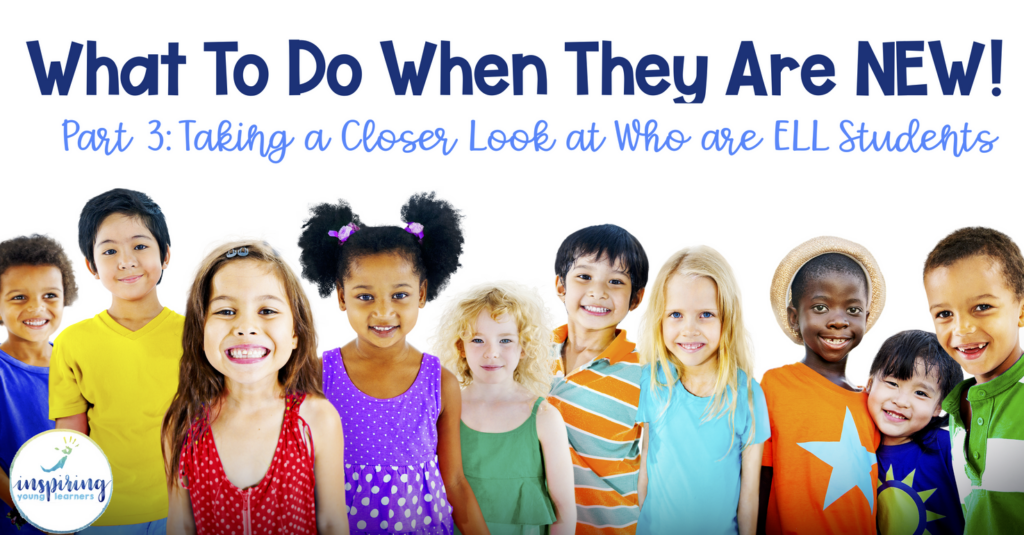A few years ago I found myself sitting at a church potluck with some older women from my church. I’m not sure how we got on the topic, but somehow this comment was made by one of the older women… “If people can’t learn English, then they should go back to their country.”
Sound familiar? Have you heard someone share that same sentiment with you? Or have you maybe felt that yourself?
Listen… I get the struggle of being a homeroom teacher and having students not speak any English. I understand the burden you might feel of figuring out ways to support these types of learners, and the lack of resources you might have. However, today’s post will helpfully shift your mindset and see the incredible opportunity you have to change the future.
Did you know that 82% of K-5 elementary students are American-born?
I was shocked by the number, but seeing that also gave me a thought that I didn’t have earlier in my teaching career. If I’m honest, earlier on in my teaching, I made the assumption that the students I was working with would eventually return to their home country and I approached it as more of a temporary situation. Have you every made this same assumption?
Reflecting on this stat, shifting my mindset, made me realize that we, as teachers, have this incredible opportunity to shape the future of our country. It made me realize that we can create a future generation where bilingualism is the norm as well as something that is celebrated. It made me realize that we can instill respect and appreciation of cultural diversity in our classrooms today so that there will be real unity in diversity tomorrow.
When we shift our mindsets, we can begin to see each student as an asset to our country, our society, and our world instead of a problem that will be fixed once they learn English.
Today’s post is going to breakdown who it is we are talking about when it comes to English language learners, and also some possible misconceptions you might have when working with ELLs.
Here are some examples of different types of ELLs you might be working with.
SIFE Students Students with Interrupted Formal Education. These are students who usually are coming from war-torn places and most likely are lacking foundational skills. It is crucial to provide emotional support as well as academics because of the difficult situations they are coming from. I’ve included below two great resources to learn more about supporting SIFE students in your school.
ELLs born outside the U.S.Each year, the United States is receiving more and more families and students who are immigrating from another country. Although this number is increasing, immigrant students are actually a small number of our ELL students. The large percentage of our ELL students in the United States are born here.
ELLs born in the U.S.According to Colorin Colorado, 82 percent of pre-kindergarten to 5th grade ELL students and 62 percent of 6th to 12th grade ELL students are born in the U.S. (Zong and Batalova, 2015). I believe this is worth mentioning because it might shift how you view the students you are working with. These students are the future of the United States, and you have the incredible privilege of teaching these students the skills to make our country a better place! Along with giving you a quick rundown I want to share with you some insights I have observed because of my experience living abroad. Living abroad has opened my eyes to see a different culture, a different life, and a different way of doing things.
Here are 3 misconceptions I had before I lived abroad about ELLs, and how we can change them.
1. ELL students understand their families cultural traditions. I LOVE learning about other cultures, and I think creating cultural acceptance and respect in the classroom is vital. What I want to share with you though is to allow the students to share about the culture they connect with and not try to push their family culture. I am seeing this played out with my daughters who go to school in Spanish and live in a Spanish speaking country. We are American and speak English at home, but the culture they are familiar with is Panama. All they know is Panama, and if you were to ask my older daughter Isabella about her “culture” she would tell you about the Panama flag, the Panamanian dress which is called a pollera, and the common dance here called tipico. The only thing she would be able to tell you about the United States would probably be that her grandparents live there. I say this because many times as teachers who work with diverse cultures, we want the students to share about their culture, but they might only know the culture that they are growing up in. I am not discouraging you against discussing culture, but I’m encouraging you to create opportunities for students to feel comfortable and talk about whatever “culture” is to them!
2. ELLs are behind in their English speaking peers academically. If I’m being completely transparent, I have found at times I can make judgments on people’s academic abilities by their ability to speak English. A few weeks back I was having coffee with a woman who was working on learning English. She is a Spanish speaker from Peru and was spending time here in Panama learning English. She spoke really well for the amount of time she had spent learning English, but at times had a few grammar and vocabulary mistakes to correct. She was similar to me in my ability to speak Spanish, and so that’s how I thought of her language ability. Later on during our conversation did I find out that she not only knew Spanish, but she learned Russian and had received an engineering degree in Russian. Then went on to Germany to learn German, and English was her fourth language learned. Wow, did I feel like an idiot!
The point to this story is, whether your ELL students know one language or more, they might be behind in English right now, but they will be ahead if we cultivate bilingual opportunities. Affirming their ability to speak another language, and showing how cool that is to their classmates, will give them the confidence to try English!
3. ELLs should be able to adjust to the school setting quickly. As we discussed earlier the different types of ELL students, you might have, please keep that in mind as they enter your classroom. Right now as I’m typing this, I’m looking at one of the public schools here in Panama. It is completely run down, no air conditioning, and very little decoration on the inside or outside. It’s a pretty basic concrete structure with no bells or whistles. I have visited schools in other countries, and they are similar to what I’ve seen here. They are drastically different then what a school in the U.S. looks like. You never know how overwhelming the decorations, books, and materials might feel to your new student. I’m not saying to change it, but keep this in mind as the adjust to the new setting. Respect the silent period, and do what you can to create a comfortable environment for learning and acceptance.
If you are new to working with ELLs, make sure you go back and read post 1 and 2 of this series! Also, sign up for my newsletters so that you receive every new post that comes after this. I promise to walk with you on this journey of teaching ELLs, so you feel confident and comfortable reaching the needs of all your learners!
Looking for resources to help support your ELLs? Just sign up here for access of a growing collection for both you and your students!

Have a question about ELLs? Email me at inspiringyounglearners@gmail.com! I’d love to help!
Want to learn more? Check out these great resources specifically about SIFE students. http://www.colorincolorado.org/article/how-support-ell-students-interrupted-formal-education-sifes https://www.amazon.com/Boosting-Achievement-Carol-Salva/dp/0997740256/ref=sr_1_1?crid=2RNJ2DR0FN6CL&keywords=boosting+achievement&qid=1551197466&s=gateway&sprefix=boosting%2Caps%2C197&sr=8-



